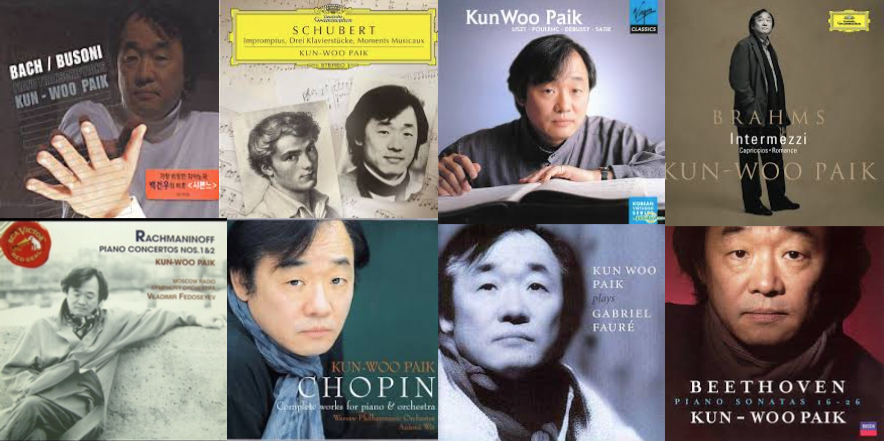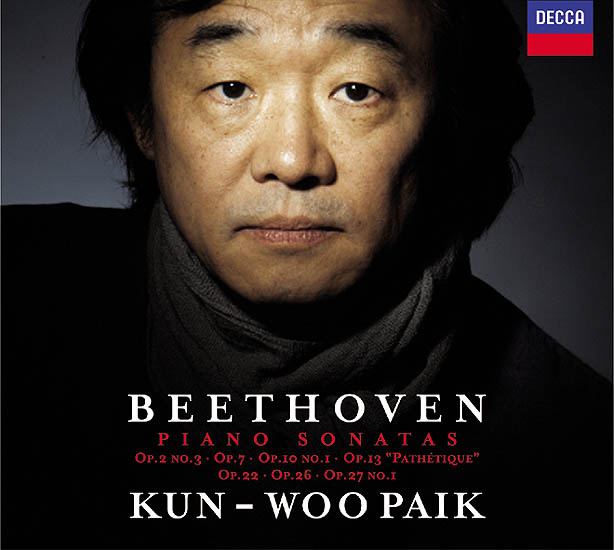
Kun-Woo Paik and Beethoven, Endless journey
By Prof. Satoru Sakaku, musicologist, professor at Tokyo University, for Auditorium Magazine. Translation to English by Mrs. Miyoko Weissenberg
Kun-Woo Paik in 2017 has been continuing his pilgrimage with Beethoven’s piano sonatas for over 6 months. From the end of March to the middle of October, thirty-two recitals were given in 24 cities of Korea, the same number of recitals as that of complete piano sonata works by Beethoven. He kept playing exclusively Beethoven’s piano sonatas. The recital was titled as “ Kun-Woo Paik and Beethoven, Endless journey”. I found it is a well-thought title, as the concept of “journey” is not linked to classical music in Japan. The climax of these continuous recitals cycle was the complete 32 works of Beethoven piano sonata’s recitals held at the concert hall of Seoul Arts Center from September 1st to 8th. It has been 10 years since Mr. Paik had presented the complete sonatas in 2007, and he must be surely the first Korean pianist having performed complete sonatas recitals for two times.
In the past when «Beethoven performers» like Backhaus, Kempff, Serkin or Arrau had been active, they were presenting Beethoven’s complete piano sonatas wherever they went. Even nowadays, there are pianists such as Rudolf Buchbinder, whose specialty is Beethoven’s complete piano sonatas performance. But they do not have repertoires as large as that of Mr. Paik’s, and it was not necessary for them to have that. How Mr. Paik who acquires such diverse repertoires of piano music represents his second performance of complete piano sonatas by Beethoven, a decade after his first recitals? It is an “event“ for not only Asia but also in the whole world of piano performance. I, who heard his performance of complete works 10 years ago at Guangzhou in China, went to Seoul to listen all of the recitals as well.
The most important aspect of performing the complete piano sonatas recitals is to construct the structure of the program. How these 32 works can be combined, by period of composition, tonality, scale of the piece or level of difficulty, or where “The well-known sonata” shall be included in the program (obviously one must think of marketing), etc., the pianist is tested to be intellectually insightful and musically analytical, and for listener it brings pleasure of discovering the performer’s intention of the program.
What Mr. Paik has represented in his program must be one of a “model response”. One shall pay attention to the fact that it is not the same program structure as that of 10 years ago. He was also using the score by Heinrich Schenker’s editions for this recitals. As far as I remember, he must has been using score by Henlé editions at the recitals of 10 years ago.
- Sep. 1st.: Sonata nº 20, nº 1, nº 19 / nº 15 «Pastoral», nº 8 «Pathétique»
- Sep. 2nd.: Sonata nº 5, nº 3 / nº 12, nº 14 «Moonlight»
- Sep. 3rd.: (afternoon) Sonata nº 6, nº 7 / nº 16, nº 17 «The Tempest»
- Sep. 4th.: (evening) Sonata nº 10, nº 2 / nº 22, nº 23 «Appassionata»
- Sep. 5th.: Sonata nº 11, nº 18 «The hunt» / nº 9, nº 25, nº 21«Waldstein»
- Sep. 6th.: Sonata nº 4, nº 24 / nº 13, nº 26 «Les adieux»
- Sep. 7th.: Sonata nº 27, nº 28 / nº 29 «Hammerklavier»
- Sep. 8th.: Sonata nº 30, nº 31, nº 32 (without intermission)
I will give you a brief summary of my impressions as follows. The first recital which gives an overview of the early period of Sonatas known to be the three core works for piano students (nº 1, nº 19, nº 20), was a the most pedagogical and a rare opportunity to be performed by such a great Piano master as Mr. Paik. The second movements of «Pastoral» and «Pathétique» were performed with such deep feeling and became the moments of the night.
The second recital was combined by related tonality in major and minor in each session; one could feel at the latter part that there was the image of a funeral procession. The dotted rhythm that appeared in the first movement of the moonlight sonata implies a funeral bell and not the moonlight shining upon lake Leman* if the musical-rhetorical figure is taken for granted. He performed the 2nd and 4th movement of the «Funeral March sonata» and the last movement of «Moonlight sonata» lively with plenty of energy, displaying the contrast between life and death.
At the third and fourth recital, he performed sonatas from the early period to two works (nº 16, nº 17) which led to «new road», then «Appassionata», offering various styles of 8 sonata pieces in one day held listeners’ attention. How marvellously he played at the short cadenza of 90 measures in the second movement of nº16! His performance of «The Tempest» and «Appassionata» which he also performed in Japan in the past, reminded me of the important Sumo match between highest-ranged «Ōyokozuna» sumo wrestlers’. He dominated the hall by his sense of uniformity in concentrated expressions at the last movement of « The Tempest», or by the coda in «Appassionata» which made me imagine an explosion of galaxy.
Mr. Paik’s’ fifth recital was quite brilliant, with his dynamic and passionate performance at the last movements of « The hunt» and « Waldstein», or with optimum expressions given to nº9 and nº 25 sonata which were like chamber music. At his 6th recital, three sonatas in E-flat major were aligned, he carefully represented each characteristic part in these movements, and the splendid performance of «Les adieux» deserved to be the final to conclude this recital.
Only the later period of 6 sonatas are left for recitals at last. The Sonata nº 27and nº 28 played in the first part of 7th recital could have been even better performed and be excellent by such an experienced and accomplished pianist as Mr. Paik. This was because probably at the beginning of nº 27, the chord of his right hand did not play as he intended and the first movement became incoherent due to this unexpected occurrence. It seemed to me that there is still some room left for consideration for tempo of each movement of No.28’s. The second and last movement’s allegro could have been adequate with a slightly calmer tempo. It is normal to have such occurrences, as recitals are organised almost every day, for 8 times.
His performance of «Hammerklavier» deserves to be one of the best performance one could listen at present. Among other active pianists, maybe Mr. Grigory Sokolov is the only one who can perform as same level as Mr. Paik. Mr. Sokolov’s Hammerklavier can be described as if he constructs in more than 50 minutes a great complex of Buddhist temples, while Mr. Paik will let us hear with large scale of lively grace of “Qi” (energy flow according to Chinese tradition), which he brought from the space. When it comes to the third movement, there is no one aside from Mr. Paik who could express such human and profound emotions.
On the eighth recital, Mr. Paik performed the three last sonatas perfectly, bringing the whole audience to completely a different world. The profound silence that came after he played the last cord of the last sonata, was the most noble and sublime moment achieved after the performance of 32 works by this superhuman pianist. Even if it was not done this time, I hope one day the 6 sonatas live performance would be recorded on CD.
It shall also be mentioned that the audience listened motionlessly to each one of 32 sonatas. Korea is at present a leading country of piano in Asia where they produce many young talented pianists. This is made possible due to people such virtuosos as Mr. Paik, teachers who have a global vision, and audiences who have great sensibility and ability to grasp musical expressions and emotions. The audiences who sincerely enjoy the performance, and give an explosive applause as soon as performance is finished (also endless requests for autographs and souvenir picture taking), are the ones supporting the foundation of Korean Piano world’s prosperity.
All together, the interpretation of Beethoven’s sonata by Mr. Paik during the cycle of these recitals was different from that of 10 years ago, and also from what we hear from CD. His free performing style was quite astonishing. He split in two hands for leaps of octave and chords in « Hammerklavier» and beginning of No.32, also in the same way for the opening part (so called the phrase of “Mannheim rockets”) and in bar 16-17th. of the No.7 on the third movement. He is often at a standstill when his impulsive desires for musical expression exceed the capability of piano as the instruments, but this shall be accepted as one of his characteristic side of his art.

His pianism from technical, physical and mental aspects are all at a complete maturity state. In my opinion, the essential qualities in his performance is his capacity of «spirit channeling ». While the ultimate goal of occidental music is to go beyond, ascending to heaven, to an ideal world, Mr. Paik communicates with composers’ spirit in heaven when interpreting his compositions, and brings them back to be possessed as he likes. It is an opposite vector.
This “possession” creates a particularly realistic atmosphere as if Beethoven himself was playing during Mr. Paik’s performance, and became a source for such a strong persuasion to the audience. In other words, Mr. Paik is a Shaman piano performer (or, Mudang and Baksu in Korean Shamanism), with the aesthetics, which have Asian particularity. Such « possessive » style of pianists are not seen in Korea nor in Asia.
Spiritually rich and sophisticated “Theatricality“, in his production of music and gesture during his performance is also his particularity and not seen with other pianists. I wonder if he obtained this capacity through the influence of his beloved Partner Yoon Jeong-hee. This quality brings the best effect when one interprets works of composer such as Beethoven, whose musical works are mainly constituted of dramatical contrasts.
Previously, Mr. Paik had realized “Theatricality “ and “possession” though great amount of concentration and strong determination. But since this recital, these elements are more relaxed, and we see as ”Two beings”, Beethoven and Mr. Paik appearing freely one after another during performance. He succeeds to give the ideal expressions depending on the musical character of each movement on sonata, and made almost the best interpretation we can listen.
There is another thing that became clear to me. It is his future picture. Mr. Paik will probably be the first Asian master pianist who will be successful at forefront throughout his life, like Mr. Horowitz who was recording until the day before he passed away, or Mr. Rubinstein who gave recitals until 89 years old, or Mr. Horszowski who was an active performer until 99 years old. Mr. Paik’s achievement of this second integral Beethoven piano sonata recitals, brought his pianism and as a person too, to a new higher level. One shall keep more eyes on his further success.
